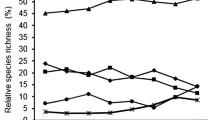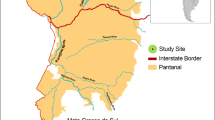Abstract
The composition of an avian foliage-gleaning guild was analyzed with respect to body size at nine sites along an elevational gradient in the Oregon Cascades. Mean body size decreased from 20.5 g near the lower forest boundary where it meets the grassland at about 775 m to 9.3 g near timberline at about 1720 m. Both the loss of larger species and the gain of smaller species contributed to the change. Mean volume of the foliage-dwelling arthropods also decreased with increasing elevation by two orders of magnitude along the same gradient. A significant decrease in body size occurred in three arthropod groups, larval Lepidoptera, Homoptera, and spiders, and of these, larval Lepidoptera dominated the overall size trend among arthropods. Both developmental differences (higher elevation sites are delayed seasonally on the same calendar date) and taxonomic differences contributed to the change in mean arthropod size. Mean bird size was positively correlated (r=0.93) with the body size of foliage-dwelling arthropods. A similar pattern was suggested for other avian guilds dependent directly or indirectly upon foliage-dwelling arthropods, but not for guilds independent of foliage-dwelling arthropods.
Similar content being viewed by others
References
Anderson SH, Shugart HH (1974) Habitat selection of breeding birds in an east Tennessee deciduous forest. Ecology 55: 828–837
Ashmole NP (1968) Body size, prey size, and ecological segreation in five sympatric tropical terns (Aves: Laridae). Syst Zool 17: 292–304
Austin GT (1970) Breeding birds of desert riparian habitat in southern Nevada. Condor 72: 431–436
Bedard J (1969) Adaptive radiation in Alcidae. Ibis 111: 189–198
Beedy EC (1981) Bird communities and forest structure in the Sierra Nevada of California. Condor 83: 97–105
Bent AC (1946) Life histories of North American jays, crows, and titmice. US Natl Mus Bull 191
Bent AC (1948) Life histories of North American nuthatches, wrens, thrashers and their allies. US Natl Mus Bull 195
Bent AC (1949) Life histories of North American thrushes, kinglets, and their allies. US Natl Mus Bull 196
Bent AC (1950) Life histories of North American wagtails, shrikes, vireos, and their allies. US Natl Mus Bull 197
Bent AC (1953) Life histories of North American wood warblers. US Natl Mus Bull 203
Bent AC (1958) Life histories of North American blackbirds, orioles, tanagers, and allies. US Natl Mus Bull 211
Bent AC (1968) Life histories of North American cardinals, grosbeaks, buntings, towhees, finches, sparrows, and allies. US Natl Mus Bull 237
Betts MM (1955) The food of timice in oak woodland. J Anim Ecol 24: 282–323
Boag PT, Grant PR (1981) Intense natural selection in a population of Darwin's finches (Geospizinae) in the Galapagos. Science 214: 82–85
Bock CE, Lynch JF (1970) Breeding bird populations of burned and unburned conifer forest in the Sierra Nevada. Condor 72: 182–189
Collins SL, James FC, Risser PG (1982) Habitat relationships of wood warblers (Parulidae) in northern central Minnesota. Oikos 39: 50–58
Dunning JB Jr (1984) Body weights of 686 species of North American birds. West Bird Band Assoc Monogr 1: 1–38
Franklin JF, Dryness CT (1973) The natural vegetation of Oregon and Washington. US For Serv Tech Rep PNW-8
Franzreb KE, Ohmart RD (1978) The effects of timber harvesting on breeding birds in a mixed coniferous forest. Condor 80: 431–441
Gibb JA, Betts MM (1963) Food and food supply of nestling tits (Paridae) in Breckland pine. J Anim Ecol 32: 489–533
Goss-Custard JD (1977) Optimal foraging and the size selection of worms by Redshank, Tringa totanus, in the field. Anim Behav 25: 10–29
Greenberg R (1979) Body size, breeding habitat, and winter exploitation systems in Dendroica. Auk 96: 756–766
Greenberg R (1981) Dissimilar bill shapes in New World tropical and temperate forest foliage-gleaning birds. Oecologia 49: 143–147
Hespenheide HA (1971) Food preference and the extent of overlap in some insectivorous birds, with special reference to the Tyrannidae. Ibis 113: 59–72
Hespenheide HA (1975) Prey characteristics and predator niche width. In: Cody ML, Diamond JM (eds) Ecology and evolution of communities. Belknap Press, Cambridge, pp 158–180
Holmes RT, Bonney RE Jr, Pacala SW (1979) Guild structure of the Hubbard Brook bird community: a multivariate approach. Ecology 60: 512–520
Karr JR (1976) Seasonality, resource availability, and community diversity in tropical bird communities. Am Nat 110: 973–994
Karr JR, Roth RR (1971) Vegetation structure and avian diversity in several New World areas Am Nat 105: 423–435
Kendeigh CS (1969) Tolerance of cold and Bergmann's rule. Auk 86: 13–25
Kilgore BM (1971) Response of breeding bird populations to habitat changes in a giant sequoia forest. Am Midl Nat 85: 135–152
MacArthur RH, MacArthur JW (1961) On bird species diversity. Ecology 42: 594–598
MacArthur RH, Recher H, Cody M (1966) On the relation between habitat selection and species diversity. Am Nat 100: 319–332
Manuwal DA (1983) Avian abundance and guild structure in two Montana coniferous forests. Murrelet 64: 1–11
Morse DH (1976) Variables affecting the density and territory size of breeding spruce-woods warblers. Ecology 57: 290–301
Poole EL (1983) Weights and wing areas in North American birds. Auk 55: 511–517
Pulliam HR (1974) Coexistence of sparrows: a test of community theory. Science 189: 474–476
Pyke GH, Pulliam HR, Charnov EL (1977) Optimal foraging: a selective review of theory and tests. Q Rev Biol 52: 137–154
Rabenoid KN (1978) Foraging strategies, diversity, and seasonality in bird communities of Appalachian spruce-fir forests. Ecol Monogr 48: 397–424
Robinson SK, Holmes RT (1982) Foraging behavior of forest birds: the relationships among search tactics, diet, and habitat structure. Ecology 63: 1918–1931
Root RB (1967) The niche exploitation pattern of the blue-gray gnatcatcher. Ecol Monogr 37: 317–350
Sabo SR (1980) Niche and habitat relations in subalpine bird communities of the White Mountains of New Hampshire. Ecol Monogr 50: 241–259
Schoener TW (1968) Sizes of feeding territories among birds. Ecology 49: 123–141
Schoener TW (1971) Large-billed insectivorous birds: a precipitous diversity gradient. Condor 73: 154–161
Schoener TW, Janzen DH (1968) Some notes on tropical versus temperate insect size patterns. Am Nat 101: 207–224
Slack RS (1975) Effects of prey size on loggerhead shrike predation. Auk 92: 812–814
Smith KG (1977) Distribution of summer birds along a moisture gradient in an Ozark watershed. Ecology 58: 810–819
Storer RW (1966) Sexual dimorphism and food habits in three North American accipiters. Auk 83: 423–436
Sturman WA (1968) Description and analysis of breeding habitats of the chickadees Parus atricapillus and P. rufescens. Ecology 49: 418–431
Terborgh JW (1980) Causes of tropical species diversity. Proc Int Ornithol Congr 17: 955–961
Turner AK (1982) Optimal foraging by the swallow (Hirundo rustica, L.): prey size selection. Anim Behav 30: 862–872
Winternitz BL (1976) Temporal change and habitat preference of some montane breeding birds. Condor 78: 383–393
Author information
Authors and Affiliations
Rights and permissions
About this article
Cite this article
Janes, S.W. Variation in the species composition and mean body size of an avian foliage-gleaning guild along an elevational gradient: correlation with arthropod body size. Oecologia 98, 369–378 (1994). https://doi.org/10.1007/BF00324226
Received:
Accepted:
Issue Date:
DOI: https://doi.org/10.1007/BF00324226




